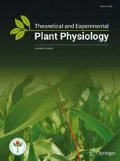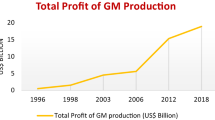Abstract
Unjustified concerns about the safeness of genetically modified crops (GMCs) have delayed both biotechnological research and the generation of genetically improved varieties more suitable to cope with the recent challenges for food production. A rising worldwide population demands more food and natural resources to satisfy its’ needs, and at the rate things are happening it is obvious that agriculture will not be able to handle the constant abiotic and biotic threats that accompany crop production. Thirty years ago the first plant genetic modifications set out the basis of a new scientific branch that offers multiple options to cope with the threats against agriculture. Following the first GMCs in the beginning of 1980s, the acreage of GMCs worldwide increased constantly, improving yield production, reducing environmental pollution caused by agrochemicals and increasing the income of the countries that produce GMCs. More than a half of South American countries produce GMCs with few varieties generated by huge companies and almost with the same traits, therefore, it is necessary to develop new regional strategies to deal with specific problems of the South American agriculture considering the local crops and varieties. This review intends to provide a brief description of the first approaches of GMCs around the world and the current status of GMCs in South America (S. Am).



Similar content being viewed by others
Notes
These reference articles are only examples and do not necessarily represent the original research for each crop that derived in the commercial lines.
References
APHIS-USDA (1992) Petition No. 92-196-01p. Animal and Plant Health Inspection Service. http://www.aphis.usda.gov/brs/aphisdocs/92_19601p.pdf. Accessed 29 October 2013
Barton K, Chilton M (1983) Agrobacterium Ti plasmids as vectors for plant genetic engineering. Methods Enzymol 101:527–539
Barton K, Binns AN, Matzke AJM, Chilton M (1983) Regeneration of Intact tobacco plants containing full length copies of genetically engineered T-DNA, and transmission of T-DNA to RI progeny. Cell 32:l043–1033
Bass MS, Finer M, Jenkins CN, Kreft H, Cisneros-Heredia DF, McCracken SF, Pitman NCA, English PH, Swing K, Villa G, Di Fiore A, Voigt CC, Kunz TH (2010) Global conservation significance of Ecuador’s Yasuni National Park. PLoS One 5(1):e8767. doi:10.1371/journal.pone.0008767
Bebber DP, Ramotowski MA, Gurr JS (2013) Crop pests and pathogens move polewards in a warming world. Nature Climate Change. doi:10.1038/nclimate1990
Brookes G, Barfoot P (2006) GM crops: The first ten years—global socio-economic and environmental impacts. ISAAA Brief No. 36. ISAAA, New York
Brookes G, Barfoot P (2008) Global impact of biotech crops: socio-economic and environmental effects, 1996–2006. AgBioForum 11(1):21–38
Brookes G, Barfoot P (2012) The income and production effects of biotech crops globally 1996–2010. GM Crops Food 3(4):265–272
Bruinsma J (2003) World agriculture: towards 2015/2030 an FAO perspective. Earthscan Publications Ltd, London
Christou P, McCabe DE, Swain WF (1988) Stable transformation of soybean callus by DNA-coated gold particles. Plant Physiol 87:671–674
CIB (2013) Brazilian Commercial Approvals. Conselho de Informações sobre Biotecnologia. http://cib.org.br/biotecnologia/regulation/ctnbio/brazilian-commercial-approvals/. Accessed 30 October 2013
FAO (2013) Food Security Statistics. Food and Agriculture Organization of United Nations. http://www.fao.org/hunger/en/. Accessed 26 October 2013
FAOSTAT (2014) Crops (Harvested area), South America, all items. http://faostat3.fao.org/faostat-gateway/go/to/download/Q/QC/E. Accessed 23 March 2014
Fermín G, Tennant P, Gonsalves C, Lee D, Gonsalves D (2005) Comparative development and impact of transgenic papayas in Hawaii, Jamaica, and Venezuela. In: Peña L (ed) Transgenic plants. Humana Press Inc., New York, pp 399–430
Fitch M, Manshardt R, Gonsalves D, Slightom JL, Sanford JC (1990) Stable transformation of papaya via microprojectile bombardment. Plant Cell Rep 9:189–194
Fitch MMM, Manshardt RM, Gonsalves D, Slightom JL, Sanford JC (1992) Virus resistant papaya plants derived from tissues bombarded with the coat protein gene of papaya ringspot virus. Bio/Technology 10:1466–1472
Gonsalves D (1998) Control of papaya ringspot virus in papaya: a case study. Ann Rev of Phytopathol 36:37–415
Herrera-Estrella L, Depicker A, Van Montagu M, Schell J (1983) Expression of Chimaeric genes transferred into plant cells using a Ti plasmid-derived vector. Nature 303:209–213
Hinchee MAW, Connor-Ward DV, Newell CA, McDonnell RE, Sato SJ, Gasser CS, Fischhoff DA, Re BV, Fraley RT, Horsch RB (1998) Production of transgenic soybean plants using agrobacterium-mediated DNA transfer. Nat Biotechnol 6:915–922
Horowitz J (2009) The income-temperature relationship in a cross-section of countries and its implications for predicting the effects of global warming. Environ Resour Econ 44:475–493
IGC (2014) International Grains Council. http://www.igc.int/en/grainsupdate/sd.aspx?crop=Totalg. Accessed 24 March 2014
ISAAA (2013) GM Approval Database. http://www.isaaa.org/gmapprovaldatabase/default.asp. Accessed 18 February 2013
IS-MPMI (2014). International Society for Molecular Plant-Microbe Interactions. http://www.ismpminet.org/about/aboutISMPMI.asp. Accessed 23 March 2014
James C (2013) Global Status of Commercialized Biotech/GM Crops: 2013. ISAAA Brief No. 46. ISAAA, New York
James C, Krattiger AF (1996) Global review of the field testing and commercialization of transgenic plants, 1986 to 1995: The First Decade of Crop Biotechnology. ISAAA Briefs No. 1. ISAAA, New York
Joyce P, Hermann S, O´Connell A, Dinh Q, Shumbe L, Lakshmanan P (2013) Field performance of transgenic sugarcane produced using Agrobacterium and biolistics methods. Plant Biotechnol J. doi:10.1111/pbi.12148
Koziel MG, Beland GL, Bowman C, Carozzi NB, Crenshaw R, Crossland L, Dawson J, Desai N, Hill M, Kadwell S, Launis K, Lewis K, Maddox D, McPherson K, Meghi RM, Merlin E, Rhodes R, Warren WG, Wright M, Evola SV (1993) Field performance of elite transgenic maize plants expressing an insecticidal protein derived from Bacillus thuringiensis. Nat Biotechnol 11:194–200
Kramer MG, Redenbaugh K (1994) Commercialization of a tomato with an antisense polygalacturonase gene: the FLAVR SAVR™ tomato story. Euphytica 79:293–297
Mishra MK, Slater A (2012) Recent advances in the genetic transformation of coffee. Biotechnol Res Int. doi:10.1155/2012/580857
Moloney MM, Walker JM, Sharma KK (1989) High efficiency transformation of Brassica napus using Agrobacterium vectors. Plant Cell Rep 8(4):238–242
Oerke EC (2006) Crop losses to pests. J Agric Sci 144:31–43
Perlak FJ, Deaton RW, Armstrong TA, Fuchs RL, Sims SR, Greenplate JT, Fischhoff DA (1990) Insect resistant cotton plants. Bio/Technology 8:939–943
Pingali PL (2012) Green revolution: impacts, limits, and the path ahead. PNAS 109(31):12302–12308
Powell P, Nelson RS, De B, Hoffmann N, Rogers SG, Fraley RT, Beachy RN (1986) Delay of disease development in transgenic plants that express the tobacco mosaic virus coat protein gene. Science 232:738–743
Ray DK, Mueller ND, West PC, Foley JA (2013) Yield trends are insufficient to double global crop production by 2050. PLoS One 8(6):e66428. doi:10.1371/journal.pone.0066428
Sheehy RE, Kramer M, Hiatt WR (1998) Reduction of polygalacturonase activity in tomato fruit by antisense RNA. Proc Natl Acad Sci 85:8805–8809
Taiz L (2013) Agriculture, plant physiology, and human population growth: past, present, and future. Theor Exp Plant Physiol 25(3):167–181
Tan GX, Shibasaki R (2003) Global estimation of crop productivity and the impacts of global warming by GIS and EPIC integration. Ecol Model 168:357–370
UN-ESA (2013) World Population Prospects: The 2012 Revision. United Nations Department of Economic and Social Affairs. http://esa.un.org/wpp/Excel-Data/population.htm. Accessed 25 March 2014
World Bank (2013) World Bank Open Data. The World Bank: Washington. http://data.worldbank.org/. Accessed 26 October 2013
Zainuddin IM, Schlegel K, Gruissem W, Vanderschuren H (2012) Robust transformation procedure for the production of transgenic farmer-preferred cassava landraces. Plant Methods 8:24. doi:10.1186/1746-4811-8-24
Acknowledgments
To Miriam Juan Qui for her support and Sophia C. Loayza Cabezas for her valuable comments and suggestions during the writing of this review.
Author information
Authors and Affiliations
Corresponding author
Rights and permissions
About this article
Cite this article
Idrovo Espín, F.M., Santamaría, J.M. An overall viewpoint of 30 years of genetically modified crops on the South American perspective. Theor. Exp. Plant Physiol. 26, 127–134 (2014). https://doi.org/10.1007/s40626-014-0011-5
Received:
Accepted:
Published:
Issue Date:
DOI: https://doi.org/10.1007/s40626-014-0011-5




